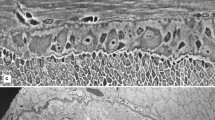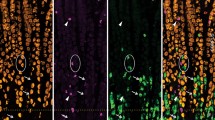Summary
Extensive secretion by exocytosis was demonstrated in the glomus (type I) cells of the adult rat after perfusion of carotid bodies with a potassium-rich (high K) glutaraldehyde fixative. Similar secretory profiles were very rare with a glutaraldehyde fixative containing a low concentration of potassium (low K). The increase in the incidence of exocytotic profiles in glomus cells with the high K fixative was highly significant, whereas no statistical difference could be observed in the incidence of coated pits with the different fixatives.
Exocytotic profiles were characterized by the following features: (1) they predominated in non-synaptic regions, but were occasionally observed near synapses between two glomus cells; they were not observed near synapses between glomus cells and nerve terminals; (2) extruded electron-dense material associated with coating of the cell membrane was frequent; (3) different stages of dissolution of the extruded granule material was evident.
The possible role of exocytosis as a mode of secretion in the glomus cells and the characteristics of the new high K-glutaraldehyde fixative are discussed.
Similar content being viewed by others
References
Aunis D, Hesketh JE, Devilliers G (1979) Freeze-fracture study of the chromaffin cell during exocytosis: evidence for connections between the plasma membrane and secretory granules and for movements of plasma membrane-associated particles. Cell Tissue Res 197:433–441
Böck P (1982) The Paraganglia. Handbuch der mikroskopischen Anatomie des Menschen (A. Oksche, L. Vollrath, eds.) Teil VI/8. Springer, Berlin Heidelberg New York, p 315
Douglas WW (1968) The first Gaddum memorial lecture. Stimulus-secretion coupling: the concept and clues from chromaffin and other cells. Brit J Pharmacol 34:451–474
Douglas WW (1981) Aspects of the calcium hypothesis of stimulus-secretion coupling: electrical activity in adenohypophyseal cells, and membrane retrieval after exocytosis. In: Hand AR, Oliver C (eds) Basic mechanisms of cellular secretion. Methods in Cell Biol. Vol 23, Academic Press, New York, pp 483–501
Eränkö O (1967) The practical histochemical demonstration of catecholamines by formaldehyde-induced fluorescence. J Roy Micr Soc 87:259–276
Gonzalez C, Fidone SJ (1977) Increased release of 3H-dopamine during low O2 stimulation of rabbit carotid body in vitro. Neurosci Lett 6:95–99
Grönblad M, Korkala O (1977) Loss of histochemically demonstrable catecholamines in the glomus cells of the carotid body after α-methyl-para-tyrosine treatment. Histochemistry 52:85–90
Grönblad M, Åkerman KE, Eränkö O (1979) Induction of exocytosis from glomus cells by incubation of the carotid body of the rat with calcium and ionophore A23187. Anat Rec 195:387–396
Grönblad M, Åkerman KE, Eränkö O (1980) Ultrastructural evidence of exocytosis from glomus cells after incubation of adult rat carotid bodies in potassium-rich calcium-containing media. Brain Res 189:576–581
Grönblad M, Åkerman KEO, Eränkö O (1982) Endocytotic uptake of cationized ferritin tracer into glomus cells dissociated from the carotid body of the adult rat. Cell Tissue Res 226:37–49
Hanbauer I, Hellström S (1978) The regulation of dopamine and noradrenaline in the rat carotid body and its modification by denervation and by hypoxia. J Physiol (Lond) 282:21–34
Hansen JT (1977) Freeze-fracture study of the carotid body. Am J Anat 148:295–300
Hansen JT (1981) Morphological aspects of secretion in the glomus cell paraneurons of the carotid body: evidence for calcium-dependent exocytosis. Cytobios 32:79–88
Hansen JT, Christie DS (1981) Rat carotid body catecholamines determined by high performance liquid chromatography with electrochemical detection. Life Sci 29:1791–1795
Hellström S, Hanbauer I (1981) Modification of the dopamine content in rat carotid body by metacholine and hypoxia. In: Belmonte C, Pallot DJ, Acker H, Fidone S (eds) Arterial chemoreceptors. Leicester University Press, pp 220–231
Hellström S, Koslow SH (1975) Biogenic amines in carotid body of adult rats — a gas chromatographic — mass spectrometric assay. Acta Physiol Scand 93:540–547
Hellström S, Hanbauer I, Costa E (1976) Selective decrease of dopamine content in rat carotid body during exposure to hypoxic conditions. Brain Res 118:352–355
Heuser JE, Reese TS, Dennis MJ, Jan Y, Jan L, Evans L (1979) Synaptic vesicle exocytosis captured by quick freezing and correlated with quantal transmitter release. J Cell Biol 81:275–300
Kondo H (1979) The freeze-fracture study of the rat carotid body. Anat Rec 3:591 (abst)
Kondo H (1981) Evidence for the secretion of chief cells in the rat carotid body. In: Belmonte C, Pallot DJ, Acker H, Fidone S (eds) Arterial chemoreceptors. Leicester University Press, pp 45–54
Korkala O (1975) Histochemical and electron microscopical observations on the storage of catecholamines in the carotid body during development and under experimental conditions. Dissertation for M.D. degree. Acta Instituti Anatomici Universitatis Helsinkiensis, Suppl. 9
McDonald DM, Mitchell RA (1975) The innervation of glomus cells, ganglion cells and blood vessels in the rat carotid body: a quantitative ultrastructural analysis. J Neurocytol 4:177–230
Nahorski S, Cook N, Pallot DJ, Al-Neamy K (1980) Catecholamines in cat and rat carotid bodies. J Anat 131:49 (Abstr.)
Pallot DJ, Al-Neamy KW, Mir AK, Nahorski SR (1981) Rat carotid body catecholamines: strain variations and the effects of sympathectomy and hypoxia. J Anat 133:703–704 (Abstr.)
Rubin RP (1970) The role of calcium in the release of neurotransmitter substances and hormones. Pharmacol Rev 22:389–428
Author information
Authors and Affiliations
Rights and permissions
About this article
Cite this article
Grönblad, M. Improved demonstration of exocytotic profiles in glomus cells of rat carotid body after perfusion with glutaraldehyde fixative containing a high concentration of potassium. Cell Tissue Res. 229, 627–637 (1983). https://doi.org/10.1007/BF00207702
Accepted:
Issue Date:
DOI: https://doi.org/10.1007/BF00207702




